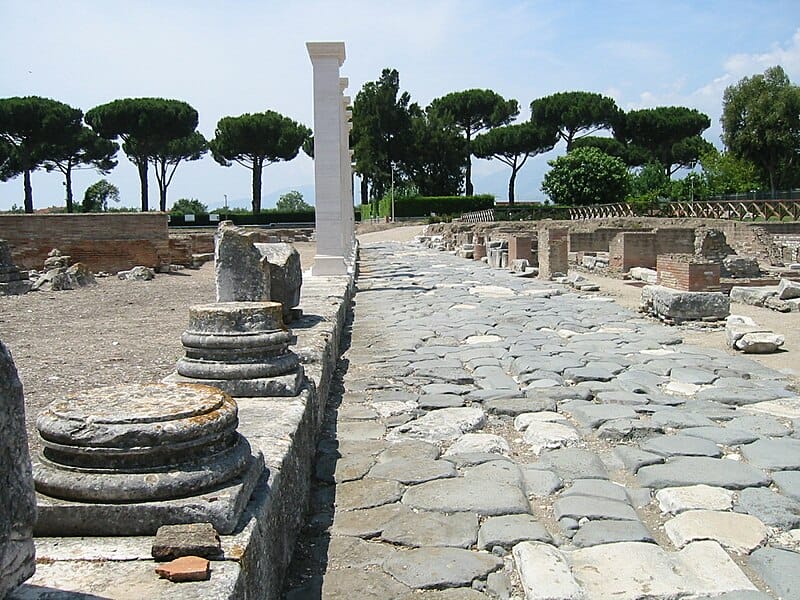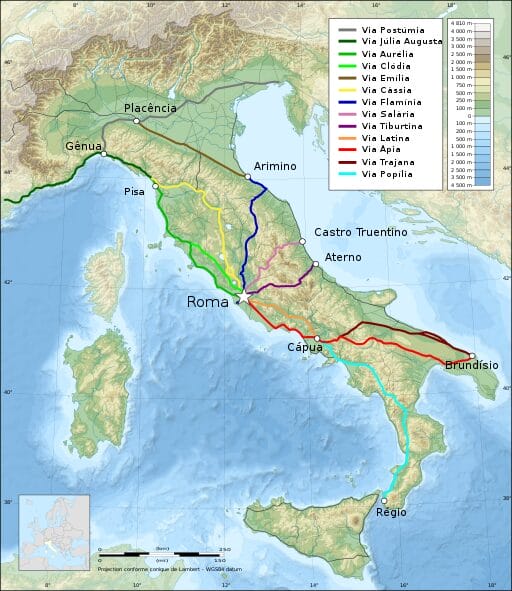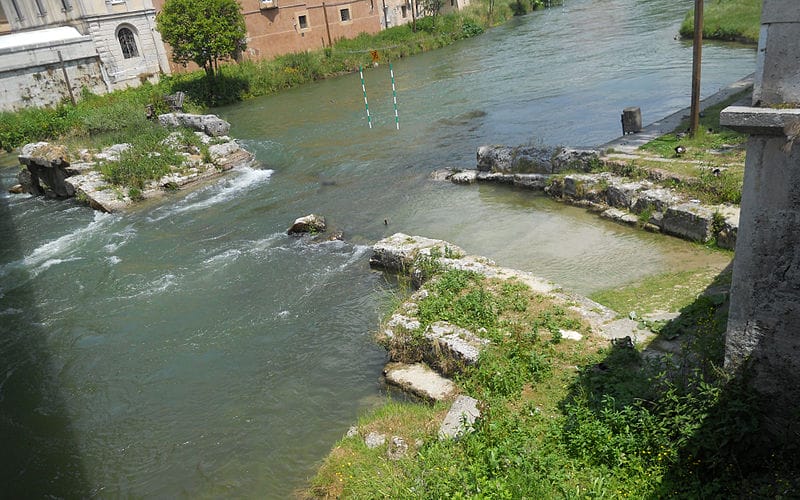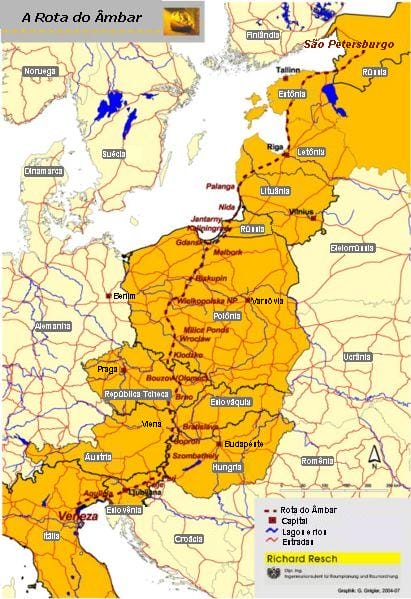The Roman Empire was the most impressive for its extensive trade routes that facilitated the exchange of goods across three continents: Europe, Africa, and Asia. These trade routes not only boosted the Roman economy but also allowed for the cultural exchange that influenced Roman society. Spanning from the luxurious silks and spices of the Far East to the grains and metals of the Mediterranean, Roman trade was a complex system of land and sea routes, some of which were inherited from earlier civilizations, and others were developed as a result of Roman expansion.

A comprehensive understanding of the top Roman trade routes offers insight into the economic dynamics of the ancient world. Key routes, such as the ones connecting Rome to far-flung regions like India, involved both overland and maritime travel, illustrating the empire’s logistical ingenuity.
Key Takeaways
- Roman trade networks were instrumental in the economic prosperity and cultural development of the empire.
- The top trade routes were vast, covering various geographic terrains and distances, requiring sophisticated logistic solutions.
- Essential goods exchanged along these trade routes included a wide variety of luxury items, raw materials, and daily necessities.
Historical Context of Roman Trade
The expansion of the Roman Empire was intimately linked with the development of trade routes that strengthened its economy and facilitated its rise.
Rise of the Roman Empire and Trade
The Roman Empire’s ascent as a dominant force in the ancient world can be attributed to both its military conquests and its strategic use of trade networks. Trade was the lifeblood of Rome, running through the Empire’s veins and enabling it not just to survive, but to thrive. Roman roads were used equally for trade and military actions.
The origin of Rome’s trade networks can be traced back to the city’s foundation and geographic positioning. Located centrally on the Italian peninsula, Rome was well-placed to control trade via both land and sea. As the Empire expanded, so too did its trade capabilities, ensuring a steady flow of goods from all corners of the known world.
The Roman economy was diverse, dealing in a vast array of goods ranging from basic foodstuffs to luxury items. Trade routes were the empire’s arteries, extending across the Mediterranean and reaching as far as the edges of India, down through North Africa, and up into Northern Europe.
The Romans showed a clear understanding of the importance of trade and its influence on their empire’s stability and growth. They built extensive road networks and maintained a powerful navy to protect their maritime trade routes. Control over the Mediterranean Sea, at times referred to as Mare Nostrum or “Our Sea,” allowed Romans to cultivate a thriving trade environment.

The empire’s trade apparatus was not only monumental in scale but also in its organizational sophistication. Port cities were developed, and warehousing techniques were refined to accommodate the influx of goods. Importantly, the Roman legal system included regulations that promoted trade, standardized currency, and protected property rights, all of which provided a stable business environment.
As the Roman Empire grew, so did its economic and trade strategies, which in turn fueled further territorial and developmental advancements. The Romans adeptly connected and exploited a myriad of trade routes that became the backbone of their economic might and an essential element in the history of their empire’s rise and success.
Top 10 Roman Trade Routes
The trade routes of the Roman Empire were extensive and sophisticated, connecting the Mediterranean basin with distant territories through a network of roads and sea paths. The land routes facilitated the movement of goods, soldiers, and civilians, while sea routes played a crucial role in the economic strength of the empire, allowing for efficient long-distance trade.
Via Appia (Appian Way)
The Via Appia, perhaps the most famous Roman road, linked Rome to Brundisium (modern Brindisi) and served as a vital artery for military and economic activities. Goods, soldiers, and information traveled along this route, which also facilitated trade with Greece, the Balkans, the Middle East, and North Africa through the port of Brundisium.
Via Aurelia

Source: Flappiefh (talk · contribs), CC BY 3.0 https://creativecommons.org/licenses/by/3.0, via Wikimedia Commons
Connecting Rome to France, the Via Aurelia was an essential coastal route along the Tyrrhenian Sea, serving as a conduit for trade and military campaigns within the western provinces of the Empire. It was instrumental in the movement of products like wine and olive oil.
Via Domitia
The Via Domitia connected Italy with Spain, forging one of the earliest Roman roads in Gaul. This route enabled the Romans to effectively administer their territories in Spain and to transport goods such as silver and other mined resources across the Empire.
Via Egnatia
Via Egnatia, a major road that traversed the Balkan Peninsula from the Adriatic Sea to Byzantium (modern-day Istanbul), played a key role in east-west trade. It also linked to other vital routes, facilitating commerce with the more eastern parts of the Empire and the territories beyond.
Via Salaria

Source: Alessandro Antonelli, CC BY 3.0 https://creativecommons.org/licenses/by/3.0, via Wikimedia Commons
Salts, crucial for food preservation and seasoning, were transported along the Via Salaria, which connected the Adriatic coast and Rome. This road underscored the value of such commodities and the extensive network required to meet the Empire’s demands.
Via Militaris (Via Diagonalis)
The Via Militaris, also known as Via Diagonalis, was a critical thoroughfare that facilitated the transport of troops and goods between the Balkans and the eastern provinces. It ensured rapid military response and steady commercial exchange in these regions.
Silk Road
Though not directly constructed by the Romans, the Silk Road was an integral trade network linking China with the Roman Empire. Luxury goods, especially silk, were transported from the East to the Mediterranean, making it a cornerstone of transcontinental commerce.
Amber Road

The Amber Road was the route that facilitated the movement of amber from the Baltic region to the Mediterranean. Amber, prized for its beauty and used in jewelry and decoration, was a highly valued commodity in the Roman Empire.
Red Sea Trade Route
The Red Sea Trade Route was a sea-based route pivotal for trade with the East. Goods were transported to the Red Sea ports, and from there, they were sent to India and the Far East. This route was a significant contributor to the wealth of the Empire, bringing spices, precious stones, and luxurious textiles to Roman markets.
Danube River Route
The Danube River route was stretching from the Black Sea to central Europe. This route facilitated the movement of goods such as grain, wine, and pottery, as well as military troops to the empire’s northern frontier. The Danube River also served as a natural boundary and defense line, aiding in the control and protection of the Roman territories. Major Roman settlements and forts were established along the river, enhancing trade and security.
Key Commodities and Goods in Roman Trade
The commerce of Rome was a mosaic of luxury imports and local specialties alongside the essential agricultural yields and primary raw materials that boosted its economy.
Luxury Imports and Local Specialties
Rome’s affluent class had an insatiable appetite for luxury items, which included ivory, purple dye, imported silks, and exotic spices, which were often seen as status symbols. Centers of production for certain luxury goods became famous for their specific contributions to Roman trade; for instance, regions in the Eastern Mediterranean were well-known for their high-quality textiles and peerless glassware, while northern Gaul produced sought-after pottery known as Terra Sigillata. Perfumes from the East and precious marbles sourced from across the empire were also highly prized in Rome, showing a sophisticated network of trade that catered to the varied tastes of Roman society.
- Silk: Mainly from China, seen as the epitome of luxury.
- Spices: Imported from India and the Far East for culinary and ceremonial purposes.
- Textiles: Egyptian linens and Mesopotamian wools were valued for their quality.
- Glassware: Specialized craftsmanship from the Eastern Mediterranean.
- Pottery: Northern Gaul’s Terra Sigillata was renowned throughout the empire.
- Purple dye: Hailed from Tyre, a symbol of nobility and high status.
- Marble: Sourced from quarries throughout the empire, and used in statues and buildings.
Agricultural Products and Raw Materials
Rome’s economic stability was anchored on agricultural produce and raw materials. Grain was the staple of Roman consumption and a significant import from provinces such as Egypt; grain shipments were critical to Rome’s political and social stability. Beyond sustenance, wine and olive oil served as both daily commodities for locals and valuable trade goods. Metals like gold, silver, copper, tin, iron, and lead were mined throughout the empire and were essential for coinage, toolmaking, construction, and various other applications.
- Grain: The cornerstone of diet, imported in large quantities from Egypt and North Africa.
- Wine: Produced in distinct regions, such as Gaul and the Italian peninsula.
- Olive oil: Common in cooking and lamp fuel, exported widely.
- Metals: Found across the empire, vital for economic and practical uses.
| Metal | Use Cases |
|---|---|
| Gold | Coinage, luxury objects |
| Silver | Currency, ornaments, utensils |
| Copper | Alloys (bronze), utensils, jewelry |
| Tin | Bronze production with copper |
| Iron | Tools, weapons, construction |
| Lead | Pipes, sarcophagi, paints |
The Roman economy integrated both luxury and primary commodities into its vast trade networks. It facilitated not only the flow of essential items for daily Roman life but also satisfied the demand for exotic and abundant goods from distant lands.
People Also Ask:
Who were the primary trading partners of the Roman Empire?
The Roman Empire’s trade network was vast and included partners across the Mediterranean, such as Egypt, Greece, and the Near East, as well as distant lands like India and China. Goods, culture, and information flowed through these relationships, highlighting the trade-driven ties Rome had established with different regions.
How did geography affect Roman trade routes at the peak of the empire’s power?
Geography was a decisive factor in shaping Roman trade routes. The empire’s strategic position afforded it control over key maritime passages like the Mediterranean Sea. Overland trade routes, such as the Silk Road’s western sections, facilitated trade with Eastern empires. Expertise in engineering enabled Romans to construct roads, bridges, and ports, which enhanced their ability to trade efficiently across their domain.
What were the major commodities traded by the Romans on the Silk Road?
The Silk Road facilitated the trade of luxury goods such as silk, spices, precious metals, gems, glassware, and art objects between the Romans and their Eastern counterparts. These commodities were highly valued in Roman society, contributing to the Silk Road’s prestige and economic significance within the empire’s trading systems.
What were three of the most commonly traded goods in the Roman Empire?
The Roman economy thrived on the trade of grain, wine, and olive oil, which were among the most commonly traded goods throughout the empire. These staples were essential for sustaining the Roman populace and were extensively cultivated and distributed across Roman territories.
How did Roman trade routes evolve over the course of the Empire?
Initially relying heavily on the Mediterranean Sea for transportation, Roman trade routes expanded with the empire’s conquests, including roads that ventured deep into continental Europe, North Africa, and the Near East. The growth in infrastructure and administrative efficiency over time facilitated more robust and far-reaching trade connections.
In comparison with the Roman Empire, what were the trade routes of the Holy Roman Empire?
While the Holy Roman Empire, centuries after the fall of the Roman Empire, covered a different geographical area centered in Central Europe, it inherited and developed its own trade routes. These trade routes were influenced by the legacy of Roman infrastructure but also by the medieval context, with notable routes including the Hanseatic League’s maritime paths and Central Europe’s overland trade conduits.
Hello, my name is Vladimir, and I am a part of the Roman-empire writing team.
I am a historian, and history is an integral part of my life.
To be honest, while I was in school, I didn’t like history so how did I end up studying it? Well, for that, I have to thank history-based strategy PC games. Thank you so much, Europa Universalis IV, and thank you, Medieval Total War.
Since games made me fall in love with history, I completed bachelor studies at Filozofski Fakultet Niš, a part of the University of Niš. My bachelor’s thesis was about Julis Caesar. Soon, I completed my master’s studies at the same university.
For years now, I have been working as a teacher in a local elementary school, but my passion for writing isn’t fulfilled, so I decided to pursue that ambition online. There were a few gigs, but most of them were not history-related.
Then I stumbled upon roman-empire.com, and now I am a part of something bigger. No, I am not a part of the ancient Roman Empire but of a creative writing team where I have the freedom to write about whatever I want. Yes, even about Star Wars. Stay tuned for that.
Anyway, I am better at writing about Rome than writing about me. But if you would like to contact me for any reason, you can do it at contact@roman-empire.net. Except for negative reviews, of course. 😀
Kind regards,
Vladimir
